Home | Category: Baleen Whales (Blue, Humpback and Right Whales)
RIGHT WHALES
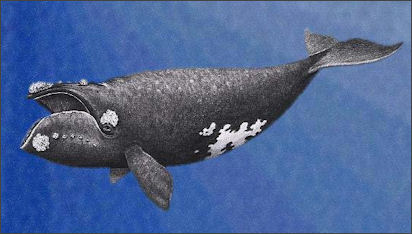
North Pacific right whale Right whales weigh about 40 to 50 tons. Their flukes (tails) are six meters (20 feet) across and their flippers have rows of bones like the foot of a land mammal. Their scientific name is “Eubalaena glacialis , which means “good, or true, whale of the ice.” [Source: Douglas Chadwick, National Geographic, October 2008; Roger and Katy Payne, National Geographic, March 1976[┴].
Whalers in the 18th century gave the right whale its common name because it was the "right" whale to kill. It swam slowly in accessible shallow, coastal waters, often lingered on the surface making it a relatively easy harpoon and kill, had an unusually rich stores of oil and baleen, or whalebone, and floated when dead. [
Whaling reduced the number of right whales from around 100,000 in the 17th century to around 11,000 today. Right whales were slow in recovering from heavy whaling in the 19th century. In recent years they have been doing better. Whaling is no longer a threat, but human interactions still present the greatest danger to this species. The leading causes of known mortality for North Atlantic right whales are entanglement in fishing gear and vessel strikes. [Source: NOAA]
Right whales have occurred historically in all the world's oceans from temperate to subpolar latitudes. They may live to be more than a 100 although 70 years old is generally given as their age limit. Using cross-sections of teeth is one way to determine a mammal’s age. However, right whales have no teeth. Therefore, ear bones and, in some cases, eye lenses can be used to estimate age in right whales after they have died.
Related Articles: CATEGORY: BALEEN WHALES (BLUE, HUMPBACK AND RIGHT WHALES) ioa.factsanddetails.com ; Articles: RIGHT WHALE SPECIES: NORTH ATLANTIC, NORTH PACIFIC, PYGMY AND SOUTHERN ONES ioa.factsanddetails.com ; ENDANGERED RIGHT WHALES: HUMANS, THREATS, SHIPS AND GULLS ioa.factsanddetails.com ; WHALES: CHARACTERISTICS, ANATOMY, BLOWHOLES, SIZE ioa.factsanddetails.com ; WHALE BEHAVIOR, FEEDING, MATING ioa.factsanddetails.com ; WHALE COMMUNICATION AND SENSES ioa.factsanddetails.com ; WHALING: HISTORY, TECHNIQUES ioa.factsanddetails.com ; ENDANGERED WHALES AND HUMANS ioa.factsanddetails.com
Websites and Resources: Animal Diversity Web (ADW) animaldiversity.org; National Oceanic and Atmospheric Administration (NOAA) noaa.gov; Fishbase fishbase.se; Encyclopedia of Life eol.org; Smithsonian Oceans Portal ocean.si.edu/ocean-life-ecosystems ; Monterey Bay Aquarium montereybayaquarium.org ; MarineBio marinebio.org/oceans/creatures
Hunting of Right Whales
The hunting of right whales has been going on for at least 1,000 years. Because right whales reside in coastal waters near human populations and were easy to exploit they were the first of the great whales to be hunted commercially. Over the centuries the animals have been taken for meat and blubber. Their oil was used in the manufacturing of soaps, candles, and lard substitutes. Before petroleum, whale oil was a valuable illuminant. The baleen of right whales was used to stiffen clothing and make whips and canes. [Source: Ariana Grasgreen, Animal Diversity Web (ADW)]
.
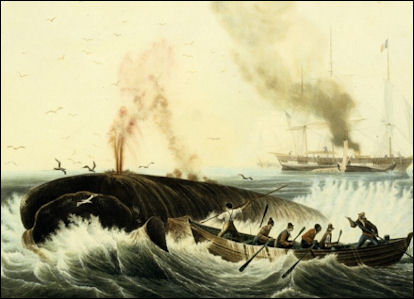 In the medieval and Renaissance Europe they provided oil for lamps. By the 16th century the eastern North Atlantic population was decimated, and whaling station where set up in North America. Stations in Labrador took 25,000 to 40,000 right whales and bowhead whales and left that population in tatters too. Right whales in the southern hemisphere didn't fair much better, Between 1785 and 1805, whalers took an estimated 12,000 Right whales off the coast of South Africa alone.
In the medieval and Renaissance Europe they provided oil for lamps. By the 16th century the eastern North Atlantic population was decimated, and whaling station where set up in North America. Stations in Labrador took 25,000 to 40,000 right whales and bowhead whales and left that population in tatters too. Right whales in the southern hemisphere didn't fair much better, Between 1785 and 1805, whalers took an estimated 12,000 Right whales off the coast of South Africa alone.
At the end of the whaling era the most valuable commodity from right whales was their baleens. Comprised of hundreds of strips, each two meters to three meters long, right whale baleens were finely fringed and flexible yet tough, making them the ideal material for umbrella ribs, horsewhips and corset stays and stiffeners in fashionable gowns.
Right whales were hunted extensively during the 19th century, with as many as 100,000 whales slaughtered during that time. They were driven close to extinction early in the 20th century and were one of the first whales to be given international protection in 1935. At the first international Convention for the Regulation of Whaling in 1935, a total ban on hunting right whales was established. The protection of this species was broadened in 1972 with the passing of the Marine Mammal Protection Act. Right whales have been slow in recovering from heavy whaling in the 19th century. In recent years they have been doing better. [Source: Jonathan Crane and Rebecca Scott, Animal Diversity Web (ADW) /=]
Balaenidae: Bowhead Whales and Right Whales
Right whales and bowhead whales are closely related. They both have huge baleens and heads. They first appeared about 22 million years ago. One reason they can grow so large is that have developed the longest and most elaborate baleens, which allow them to draw more food from the water.
Balaenidae refers to a baleen whale (mysticete) family of two genera and four species: 1) North Atlantic right whale; 2) North Pacific right whale; 3) southern right whale); and 4) bowhead whales. Bowhead and right whales can reach up to 18 meters in length and over 100 tons at maturity. Their heads are huge, nearly one tthird of their total length. The dorsal fin is often either lacking or greatly reduced. Flippers are short and rounded. The throats of balaenids are smooth, lacking the furrows or grooves of some other mysticetes. [Source: Phil Myers, Animal Diversity Web (ADW) /=]
Balaenidae are different from the other three baleen whale families: Balaenopteridae (rorquals), which include blue, fin, sei, humpback and minke whales and Eschrichtiidae ( gray whales). There is a separate baleen family for Cetotheriidae (the pygmy right whale).
According to Animal Diversity Web: The skull of balaenids has reduced nasals, and the frontals are barely exposed on the dorsal surface. The posterior border of the nasals and premaxillae lie anterior to the supraorbital processes of the frontals. The rostrum is high, narrow, and arched. Baleen plates are long and narrow, and they number more than 350 on each side of the upper jaw. The right and left baleen rows are separated in the front of the mouth. /=\
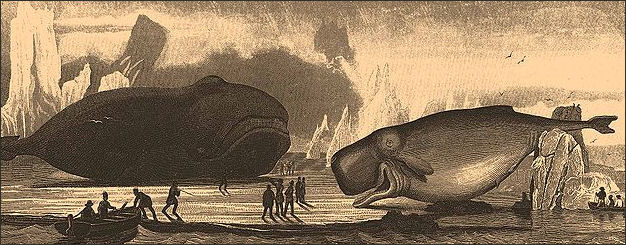
bowhead and right whales
Right whales feed largely on copepods, which they catch by swimming slowly, with their mouths open, through concentrations of these crustaceans. Water flows into the huge mouth and out between the baleen plates. Food is trapped on the fringes of the plates and scraped off with the tongue. They normally feed at or near the surface. These whales live singly or in small groups of up to three or 4 individuals. Their stocks were severely depleted by whaling, and they remain low. The name "right whale" is said to have originated because these were the "right" whales for whalers to kill. /=\
Right Whale Species
There are three right whale species: 1) North Atlantic right whale; 2) North Pacific right whale; and 3) southern right whale). North Atlantic right whales migrate along North America’s East Coast between their calving areas off northern Florida and southern Georgia and their feeding areas in the Gulf of Maine off of New England. The North Pacific right whale is found in the Pacific Ocean. The southern right whale feeds in the plankton-rich waters around the Antarctic and migrates to wintering areas near Argentina, southern Africa, western and southern Australia and sub-Antarctic New Zealand.
The three species of right whale evolved from a single species about 6 million years ago. North Atlantic and North Pacific are seriously endangered. The Southern is better off. The pygmy right whale is found in waters off New Zealand.
Northern right whales and southern right whales have been considered distinct species for some time. Northern Pacific populations are isolated from Northern Atlantic populations and are genetically distinct. Research on genetic variation in right whales in the late 1990s and early 2000s, revealed that Pacific populations of what had been considered North Atlantic right whales were in fact a distinct species more closely related to southern right whales. =\
See Separate Article RIGHT WHALE SPECIES ioa.factsanddetails.com
Right Whale Characteristics
Adult right whales are generally between 13.7 and 16 meters (45 and 52 feet) in length and can weigh up to 70 US tons (63,500 kilograms, 63.5 tonnes). Right whales are endothermic (use their metabolism to generate heat and regulate body temperature independent of the temperatures around them) and homoiothermic (warm-blooded, having a constant body temperature, usually higher than the temperature of their surroundings) and have bilateral symmetry (both sides of the animal are the same). [Source: Animal Diversity Web]
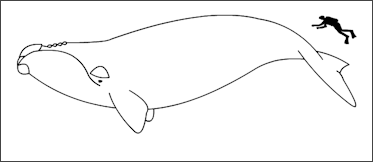
size Right whales differs from other baleen whales in that they don't have a dorsal fin, grooved throat. or long furrow-like pleats on their throat and breast that expands when the whale has a mouth full of food and water. Their flippers are very broad and short.
Right whales have two blow holes that shoot mist and vapor in the form of a "V." Curiously they have facial hair in all the places humans do, and only in those places. The whales appear to have mustaches, eyebrows, beards and even sideburns. A pink area of the of palate of the upper jaw releases excess body heat. Scientists pay special attention to an area behind the blowhole, which seems to be a good indicator of health and chance of survival. [Source: Roger and Katy Payne, National Geographic, March 1976]
Right Whale Callosities
Right whales are marked with peculiar growths called callosities, which consist of thickened white skin, sometimes many centimeters (inches) deep, with a rough outer surface. These thick, white patches are formed by cyanids, benign whale lice that feed on the whale’s dead skin. Different species of lice attach themselves to three different right whale species.
Callosities are prominent on the rostrum, near blowholes, near eyes, and on the chin and lower lip. These large crusty growths often harbor whale lice, which are crustaceans, and may appear white, orange, yellow, or pink. Hair can be found on the tips of the chin and upper jaw and is also associated with the callosities. The largest callosity, on the top of the rostrum ('snout' or beak'), is referred to as a "bonnet." Callosities emerge after birth, but a pattern of callosities is not established for seven to 10 months. Callosities may grow upwards and even break off, but their placement on a whale's head generally does not change. [Source: Ariana Grasgreen, Animal Diversity Web (ADW)]
Barnacles, lice and small organisms attach themselves to the callosities and perhaps feed on the material that spills out of the whale's mouth. The size, shape and number of callosities is unique to each whale and their pattern remains the same throughout a whales life. Scientist uses them tell the mammals apart, and they speculate that right whales may do the same thing. The large white callosity on the whales was dubbed the "bonnet" by 18th century whalers.┴
The normal function of a callosity is so took keep water out of the whale's blowhole, but during rare aggressive situations a whale may use it scrape an opponent. The whales skin is very soft, and scrapes from the crusty callosity may be quite painful. [Source: Roger and Katy Payne, National Geographic, March 1976]
Right Whale Behavior
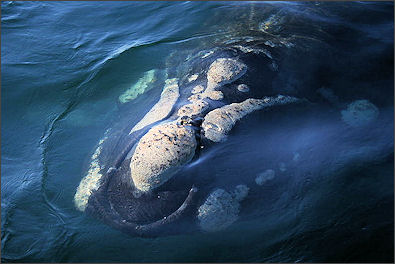
callosities Right whales are motile (move around as opposed to being stationary), migratory (make seasonal movements between regions, such as between breeding and wintering grounds) and can be both solitary and social (associates with others of its species; forms social groups). [Source: Jonathan Crane and Rebecca Scott, Animal Diversity Web (ADW) /=]
Right whales migrate seasonally and may travel alone or in small groups. In the spring, summer, and fall northern ones are found in their northern habitats, where they feed and mate. During winter, pregnant females give birth in their calving areas in the south, Groups of right whales may be seen actively socializing at the water’s surface, known as surface-active groups or SAGs. Mating occurs in SAGs, observed during all seasons and in all habitats, but SAGs likely serve other social purposes as well. [Source: NOAA]
Right whales groups can have up to 12 members but usually have two. The group composition varies from female-calf, all males, or mixed. It is difficult to determine group size because of the dispersion. A larger group may be formed at far distances staying in contact by long-distant communications. Right whales sometimes swim with other types of cetaceans. /=\
Groups of right whales can be fluid and mixed-sex. Composition of groups is rarely known because of the difficulty in determining the sex of individuals It is believed that right whales stay in the same area for days or even weeks at a time. Right whales are generally considered non-aggressive, even tender, towards other right whales, including potential mates, competing males, and young. . [Source: Ariana Grasgreen, Animal Diversity Web (ADW) /=]
Right Whale Swimming, Diving and Predators
Right whale are extremely slow swimmers, swimming at an average of 3.7 kilometers per hour (2.3 miles per hour) and rarely exceeding 5.7 kilometers per hour (9.3 miles per hour). They s can stay submerged for 30 minutes and dive to depths of 600 meters (1,970 feet).
Right whales will spend much of their time near bays and peninsulas and in shallow, coastal waters. These areas can provide shelter, food and security from predators and for females rearing young or avoiding the mating efforts of males. Southern right whale cow and calf pairs migrate at a rate of 2.7 to 4.2 kilometers per hour (1.7 to 2.6 miles per hour) over a 24-hour period. Southern right whales have been observed at near-shore swimming speeds of over 15 kilometers per hour (9.5 miles per hour) for short distances), but are generally slow swimmers. /=\
The main known predators of northern right whales are humans, orcas (killer whales) and sharks. The former usually kills them accidentally and latter two ten to go after calves or sick or injured individuals. Healthy adults can deter most predators with formidable size and strength. Sometimes right whales temporarily cluster together to form a defensive circle when threatened by a potential predator. When this happens, the whales form a circle with their heads facing the inside of the circle and flail the tails on the outside of the circle. They may also move into shallow waters but sharks and orcas can also continue their chase in these depths.
Right Whale Breaching and Lobtailing
Right whales breach — propel themselves up and out of the water — and then crashing back down with a thunderous splash. They also slap their tails (lobtailing) or their flippers (flippering) on the water’s surface. Right whales leap out of the water exposing their entire massive bodies like other whales. No one is really sure why they do it. Some scientist believe the animal are removing parasites attached to their skin; others say it is a method of feeding; while others still claim whales do to communicate with other whales. [Source: NOAA, [Source: Roger and Katy Payne, National Geographic, March 1976, ┴]

"Lobtailing" is the word used to describe the action of a whale taking its tail out of the water and thrusting it down with a "thunderous slap." Often times when one whale lobtails others will follow and it seem like an elementary form of communication. Once a mother. seemingly fed up with the playful antics of her calf, was observed swimming underneath the calf, then suddenly surfaced, cradling the calf in her flippers. ┴
There seems to a correlation between increases in wind and increases in breaching, lobtailing and flippering. One theory for these behaviors is that increased turbulence in the water makes it more difficult for the animals to communicate using low frequency noises — which is how they often speak — and thus they have to splash and produce visible signals to make themselves understood.┴
In July 2010, a 40-ton southern right whale leapt out the water in waters off of South Africa and landed on a ten-meter yacht, squirming around a bit on the deck and breaking the ships mast, before slipping back into the sea. The ship didn’t sink no one was hurt and the whale swam away. Video of the event shows the whale swimming in the direction of the yacht and suddenly leaping out of the water right next to it. Ralph and Paloma Mothes, 59 and 50, were on the yacht. Paloma told the Sun, “It was very scary the whale was the same size as the boat. We spotted it about 100 meters away and suddenly it was beside us. There where bits of skin and blubber left behind and the mast was wrecked. It brought down the rigging too.” The couple used the vessel’s engine to get back to port in Cape Town.
Right Whale Communication
Right whales sense using touch, sound, ultrasound and chemicals usually detected with smell and communicate with touch and sound. They produce low-frequency vocalizations best described as moans, groans, and pulses. Scientists suspect that these calls are used to maintain contact between individuals, communicate threats, signal aggression, or for other social reasons. [Source: NOAA]
Low-frequency noises and "belch-like utterances" are their most common sound. Low-frequency sounds are characteristic of baleen whales while high-frequency sounds are more typical of toothed whales. Other sounds are described as grunting, mooing, moaning, sighing, and bellowing. The maximum energy (Hz) recorded in southern right whales ranged from 50-500 and the duration ranged from 0.5 to 6.0 seconds. [Source: Jonathan Crane and Rebecca Scott, Animal Diversity Web (ADW) /=]
Feeding Right Whales
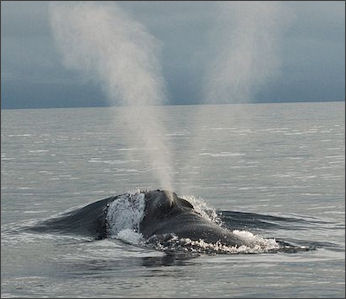
V shaped exhalation from a right whale blowhole Right whales consume plankton, krill, copepods and fish. They feed by opening their mouths while swimming slowly through large patches of minute zooplankton and copepods. They filter out these tiny organisms from the water through their baleen, where the copepods become trapped in a tangle of hair-like material that acts like a sieve. Right whales feed anywhere from the water’s surface to the bottom of the water column. [Source: NOAA]
Right whales feed from spring to fall and in winter in certain areas.. Unlike some other baleen whales, right whales are skimmers: they feed while moving with their mouth open through patches of zooplankton. [Source: NOAA]
Right whales have been observed on a number of occasions skimming water near the surface for copepods. When they feed in this way they open their huge mouths and take in huge mouthfuls of krill- or plankton filled water. They then close their mouth and use their powerful tongue to push the water back out through the baleen. As the water exits krill and other small creatures are trapped in the whales fibrous comblike baleen. The whale then scrapes the baleen with its tongue to ingests the food. In the old days, humans used flexible right whale baleen to make corsets, umbrella ribs, clock springs and riding crops.┴
Right Whale Mating
Right whales reach sexual maturity by around age 10. The gestation period for females is one year and pairs breed only once every two to four years. A slow rate of reproduction partly explains why it takes a long time for their numbers to rebound. Southern right whales and north Atlantic right whales form non-aggressive mating aggregations in which individuals engage in gentle physical contact and nuzzling. Females are likely to mate with multiple males and males do not compete aggressively for females. Behaviors associated with mating in right whales include fin and tail slapping at the surface, "headstanding," and breaching. In headstanding, right whales float at the water surface in a vertical position with the flukes extended into the air. They may also rock back and forth while in this position and hold it for several minutes. This is thought to be a mating display. Breaching and tail/fin slapping are also more common during mating aggregations and may be a kind of courtship display. [Source: Ariana Grasgreen, Animal Diversity Web (ADW) /=]
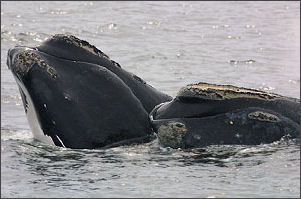 Right whales are polygynandrous (promiscuous), with both males and females having multiple partners. Mating right whales form mixed-sex groups called surface-active groups (or SAGs) in which members of both sex mingle, splash around, roll about, push and shove, and affectionately stroke each other. Even whales who have not reached sexual maturity sometimes join in, apparently drawn in by all the excitement.
Right whales are polygynandrous (promiscuous), with both males and females having multiple partners. Mating right whales form mixed-sex groups called surface-active groups (or SAGs) in which members of both sex mingle, splash around, roll about, push and shove, and affectionately stroke each other. Even whales who have not reached sexual maturity sometimes join in, apparently drawn in by all the excitement.
At this time right whales affectionately nuzzle and caress one another, rolling about randomly exposing flippers, flukes, backs, bellies, and portions of their heads. According to Animal Diversity Web: It has been noted that the male would sometimes begin precopulatory behavior by placing his chin on the exposed hindquarters of the female. It is believed that most right whales do not form permanent pair bonds. Females probably mate with multiple males. No aggression has been observed between competing males, which is a rare behavior in mammals. Courting bouts may last for an hour or two, after which participants go their own way. Both males and females are seen on their back at the water's surface but females may show this posture to move her genitalia away from a pursuing male. [Source: Jonathan Crane and Rebecca Scott, Animal Diversity Web (ADW) /=]
Right Whales Huge Sex Organs
Right whales have sex organs that can weigh over one ton. Males have the largest testes of an living mammal, weighing up to 525 kilograms, suggesting that sperm competition may play a role in determining mating success. Males have the highest testes to body weight ratio of any baleen whale and may have the largest sex organs that have ever existed in the history of the world. According to one theory when numerous males mate with the same female, the male with the largest testes has a better chance to pass on his genes by diluting the sperm of his rivals.
The sex organs of male right whales are positioned on their abdomen. Right whales have no scrotum or baculum, however they have exceptionally large testes. One north Pacific right whale was reported to have a testis two meters in length, 78 centimeters in diameter, and 525 kilograms in mass. Males have a darkly pigmented, long, slender, retractile penis that can reach 2. 2 to 2.7 meters in length. The ovaries of female right whales are also positioned on the abdomen. The largest measured ovary weighed 6.3 kilograms. Right whales have a bicornuate uterus, and it is thought a fetus can develop in either horn of the uterus, as with most baleen whales. [Source: Ariana Grasgreen, Animal Diversity Web (ADW) /=]
Right Whale Group Sex
When a female right whale is receptive as many as five or six males may group around her. In some cases the female selects one of the males that pursues her. After mating the couple often stay close, strokeing one another with their flippers and rolling together in what looks like an embrace. Sometimes the males create a big commotion but generally don't fight, and often all five or six get a chance to mate.┴
It is usually up to the female to repel unwanted advances. To make it difficult for males to mount her she will roll belly in the water. The only problem with this is that she has to eventually roll over to breath. An when she does the males push and shove to have at her. Other tricks include escaping to shallow water or sticking her tail out of the water and extended herself vertically. When she does this a male that tries to mount her has to stick his fluke out of the water, and when he aligns himself with her he can't get proper leverage to complete the act. And even if he does position himself correctly all she has to do is rotate her body away.┴
Sometimes three or four male right whales trap a female and gang rape her. The female tries to roll on her back and exposing her genitals to the air but this means he can she can not breath. Males surround her on each side and underneath. When she rolls over the nearest male attempts to mate with her. Males are less aggressive with one another than other whale species. They often cooperate with one another when trying to mate a female. One male waits while another mates.
Right Whale Calves and Child Rearing Behavior
Right whales are 4.5 to six meters in length when they are born. They grow rapidly thereafter, attaining a size of 12 meters by 18 months old. The length of lactation and dependence are not well known. Calving areas are used for calving and neonatal nursing. During the winter, many right whales feed and suckle their young in nursery areas, which are generally located in shallow, coastal waters at low latitudes. [Source: Jonathan Crane and Rebecca Scott, Animal Diversity Web (ADW) /=]
Calves are born able to swim, and mothers and calves form a very close attachment. Calves stays close to their mothers, swimming up on their backs or butting them with their heads. Mother may roll over on their backs and hold their calves in their flippers. Calves are usually weaned toward the end of their first year. [Source: NOAA]
Mothers nurse, protect, and care for their young, investing quite a lot of energy into each offspring. Little is known about the duration of lactation and care, but it is likely to be long, given the three to four year interval between breeding attempts among females. There may be a long period of association with the mother and an extended period of learning. Female right whales have strong inclinations to protect their young. Females position themselves between their claves and sources of danger including other whales, boats, aircrafts, or divers. [Source: Ariana Grasgreen, Animal Diversity Web (ADW) /=]
Southern right whale females calve every three years. Females with calves usually don't mate. The calves are born in the austral winter. Dr. Roger Payne, a biologist who has spent many years studying whales wrote: “Tiny newborns stay in constant motion for their first month. A two- or three month play stages follows: some exasperated mothers roll over and hold their young between their flippers to quiet them. In November mother and calf show signs of coordinated travel before departing for the open sea."
Right whales mother are generally very patient creatures. A calf will sometimes slide down its mother’s fluke, climb onto her back, and even cover her blowhole, with no perceptible irritation from the mother. It is another story if the mothers become separated from their calves. Such females have charged tourist boats. [Source: Roger and Katy Payne, National Geographic, March 1976]
Image Source: Wikimedia Commons, NOAA
Text Sources: Animal Diversity Web (ADW) animaldiversity.org; National Oceanic and Atmospheric Administration (NOAA) noaa.gov; Wikipedia, National Geographic, Live Science, BBC, Smithsonian, New York Times, Washington Post, Los Angeles Times, The New Yorker, Reuters, Associated Press, Lonely Planet Guides and various books and other publications.
Last Updated May 2023
